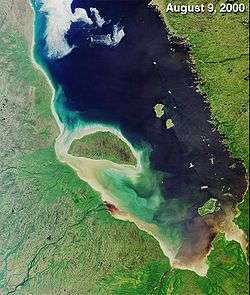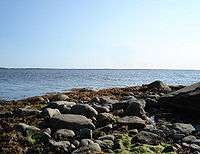James Bay
James Bay (French: Baie James, Cree: Wînipekw) is a large body of water located on the southern end of Hudson Bay in Canada. Both bodies of water extend from the Arctic Ocean, of which James Bay is the southernmost part. It borders the Canadian provinces of Quebec and Ontario. Islands within the bay, the largest of which is Akimiski Island, are part of Nunavut.
| James Bay | |
|---|---|
 A satellite image of James Bay | |
| Location | Southern end of Hudson Bay, between Ontario and Quebec. |
| Coordinates | 53°05′N 80°35′W |
| Basin countries | Canada |
| Surface area | 68,300 square kilometres (26,400 sq mi) |
Numerous waterways of the James Bay watershed have been modified with dams or diversion for several major hydroelectric projects. These waterways are also destinations for river-based recreation. Several communities are located near or alongside James Bay, including a number of Aboriginal Canadian communities, such as the Kashechewan First Nation and nine communities affiliated with the Cree of northern Quebec.
As with the rest of Hudson Bay, the waters of James Bay routinely freeze over in winter. It is the last part of Hudson Bay to freeze over in winter, and conversely the first to thaw in summer.
History
Human presence along the shores of the bay began after the retreat of the glaciers at the end of the last ice age, around 8,150 years ago. A variety of indigenous cultures have lived in this area. At the time of contact with Europeans, the indigenous peoples along both shores of the bay were ethnically Cree peoples.
Henry Hudson is believed to have been the first European to enter the bay, when he explored it in 1610 as part of his exploration of the larger bay that was named for him. This southerly bay was named in honour of Thomas James, a Welsh captain who explored the area more thoroughly in 1630 and 1631.
James Bay is important in the history of Canada as one of the most hospitable parts of the Hudson Bay region, although it has had a low human population. It was an area of importance to the Hudson's Bay Company and British expansion into Canada. The fur-trapping duo of explorers Pierre-Esprit Radisson and Médard des Groseilliers convinced the English Crown, primarily Prince Rupert of the Rhine, a favoured nephew of Charles I and cousin to Charles II, that a colonial enterprise in the north would yield wealth in minerals and fur. Des Groseilliers accompanied Captain Zachariah Gillam on the ketch Nonsuch and they jointly founded Charles Fort, the first European fur-trading post on James Bay.
Their success was such that the company was chartered by Charles II on their return, although they did not bring any minerals. This charter granted a complete trading monopoly to the company of the whole Hudson Bay basin (including James Bay). At the same time, the first English colony on what is now mainland Canada, Rupert's Land, was formed, with the first "capital" designated at Charles Fort. The first colonial governor, Charles Baley (various spellings exist, including but not limited to "Bailey"), was a Quaker, and this is believed to have been a factor in his respectful relations with the company's trading partners, the First Nations.
Significant fur trapping has continued in the region. In general, the east coast or East Main of James Bay was too easily accessed by French and independent traders from the south. The Hudson's Bay Company emphasised from an early period trading relations with tribes in interior trapping grounds, reached from the west coasts of James and Hudson bays. East Main was, nevertheless, the gateway to British settlements in what would become Manitoba (Winnipeg, for example) and as far west as the Rocky Mountains.
Geography

James Bay represents the southern extent of the Arctic Archipelago Marine ecozone. While the coastal areas are primarily in the Hudson Plains, the northeastern coast bordering Quebec is in the Taiga Shield ecozone. This rocky and hilly eastern shore forms the western edge of the Canadian Shield in Quebec and as such, the main habitat is boreal forest of the Eastern Canadian Shield taiga ecoregion. The western shore, however, is characterised by broad tundra lowlands that are an extension of the Hudson Bay Lowlands, and the vegetation is mostly muskeg bog. A large portion of this area is part of the Polar Bear Provincial Park. Ringed seals are common elsewhere along James Bay and polar bears can be seen hunting the seals as prey.[1] Beluga whales within James Bay basin could be distinct from those found in Hudson Bay.[2]
Hundreds of rivers flow into James Bay. The geography of the region gives many of them similar characteristics. They tend to be wide and shallow near the Bay (in the James Bay Lowlands), whereas they are steeper and narrower farther upstream (as they pour off the Canadian Shield). For a larger list of waterways in the region, see list of Hudson Bay rivers.
Hannah Bay
Hannah Bay is the southernmost bay of James Bay. Here the Kesagami and Harricana Rivers flow into James Bay. About 238 km2 is protected under the Migratory Birds Convention Act of Canada as the Hannah Bay Bird Sanctuary. This sanctuary has also been designated as a Wetland of International Importance under the Ramsar Convention since May 1987.
The shores in this area are a mixture of intertidal mud, sand, and salt flats, estuarine waters, intertidal marshes, freshwater ponds, swamps, and forested peatlands.[3] These elements make an abundance of wildlife.
Human development

Coastal communities
The shores of James Bay are sparsely populated. On the eastern shore in Quebec there are four coastal communities belonging to the Cree, the indigenous people of the region (from south to north):
- Waskaganish
- Eastmain
- Wemindji
- Chisasibi
On the western shore in Ontario there are five coastal communities (from south to north):
- Moose Factory
- Moosonee
- Fort Albany
- Kashechewan
- Attawapiskat
Economic development
.jpg)
Since 1971, the government of Quebec has built hydroelectric dams on rivers in the James Bay watershed, notably La Grande and Eastmain rivers. Built between 1974 and 1996, the James Bay Project now has a combined generating capacity of 16,021 MW and produces about 83 billion kWh of electricity each year, about half of Quebec's consumption. Power is also exported to the United States via a direct transmission high voltage line. The James Bay Project continues to expand, with work that began in 2010 on a new phase that involves the diversion of the Rupert River.
A proposed development project, the Great Recycling and Northern Development Canal, centres on constructing a large dike to separate southern James Bay from Hudson Bay. This would turn the bay into a freshwater lake, due to the numerous rivers that empty into it. The main benefit expected from this would be to redirect this freshwater for human use. It seems very unlikely that the GRAND Canal will actually ever be built.
Recreation
Canoeing
Many of the rivers flowing into James Bay are popular destinations for wilderness canoe-trippers. Among the more popular rivers are:
- Albany River (Ontario)
- Moose River (Ontario)
- Missinaibi River (Ontario)—recognised as a Canadian Heritage River
- Broadback River (Quebec)
- Rupert River (Quebec)—diverted in 2009 for hydroelectric development and no longer a popular destination
Two less-travelled rivers are the Groundhog River and the Harricana. The Groundhog is less travelled in modern times due to a series of seven dams that are about a day or two up-river from the Moose. Canoeists can contact the dam company and arrange to be towed around the dams on company trucks, but they must make arrangements specific to the hour, and they cannot be late. The Groundhog flows into the Mattagami. The Mattagami then flows into the Moose; it is at the meeting of the Missinaibi and Mattagami rivers that the Moose river begins, marked by an island known as Portage Island. This point is about two or three days travel by canoe to Moosonee. Though the Missinaibi and the Groundhog are both fairly high in the summer, the Moose is often quite low. Depending on the tides, groups have had to walk long stretches of the river. Rapids on the Groundhog tend to be bigger and more technical than those on the Missinaibi, but the campsites are few and poor, because the volume of travel is so much less.
The Harricana River is wild, powerful, dangerous river that flows into James Bay 40 miles (64 km) east of Moosonee after two infamous sections of river known as 1-mile and 7-mile island. Consistent whitewater and waterfalls make these sections of river extremely dangerous. Anyone wishing to take this route must allow about two days to cross the bay, an extremely dangerous proposition if the tides and the weather are unfavourable.
The most common access point for paddlers to this area is Moosonee, at the southern end of James Bay. A campsite at Tidewater Provincial Park provides large campgrounds with firepits and outhouses on an island across the river from the town. Water taxis will ferry people back and forth for about C$20 each. Many of these rivers finish near Moosonee, and paddlers can take the Polar Bear Express train south to Cochrane at the end of a trip. This train regularly features a 'canoe car' enabling paddlers to travel with their canoes.
Waskaganish, Quebec, is a town farther to the north and east on James Bay. It is accessible via the James Bay Road, and is the most common end point for trips on the Broadback, Pontax, and Rupert rivers (the town itself is situated at the mouth of the Rupert).
References
- "Sustainable Development in the Hudson Bay / James Bay Bioregion". Archived from the original on 2016-07-14. Retrieved 2016-10-24.
- Beluga whales in James Bay: a separate entity from eastern Hudson Bay belugas?
- Southern James Bay Migratory Bird Sanctuary fact sheet
Further reading
- Dignard, N. Habitats of the Northeast Coast of James Bay. [Canada]: Environment Canada, Canada Wildlife Service, 1991. ISBN 0-662-18947-7
- Francis, Daniel, and Toby Elaine Morantz. Partners in Furs A History of the Fur Trade in Eastern James Bay, 1600-1870. Kingston: McGill-Queen's University Press, 1983. ISBN 0-7735-0385-4
- Kenyon, Walter Andrew. The History of James Bay, 1610-1686 A Study in Historical Archaeology. Archaeology monograph, 10. Toronto, Ontario, Canada: Royal Ontario Museum, 1986. ISBN 0-88854-316-6
- McCutcheon, Sean. Electric Rivers The Story of the James Bay Project. Montréal: Black Rose Books, 1991. ISBN 1-895431-18-2
- Niezen, Ronald. Defending the Land Sovereignty and Forest Life in James Bay Cree Society. Cultural Survival studies in ethnicity and change. Boston: Allyn and Bacon, 1998. ISBN 0-205-27580-X
- Reed, Austin. Goose use of the coastal habitats of northeastern James Bay. Ottawa, Ont: Canadian Wildlife Service, 1996. ISBN 0-662-25033-8
- Salisbury, Richard Frank. A Homeland for the Cree Regional Development in James Bay, 1971-1981. Kingston: McGill-Queen's University Press, 1986. ISBN 0-7735-0550-4
- Siy, Alexandra. The Eeyou People of Eastern James Bay. New York: Dillon Press, 1993. ISBN 0-87518-549-5
External links
| Wikimedia Commons has media related to James Bay. |
- "James Bay Road website" Extensive and detailed information on the James Bay region of Quebec, as well as the James Bay and Trans-Taiga Roads.
- "The Rupert River website" Read about and see this endangered river soon to be diverted by Hydro-Québec.
- "Dammed river" special feature on James Bay from Canadian Geographic.
- CBC Digital Archives - James Bay Project and the Cree